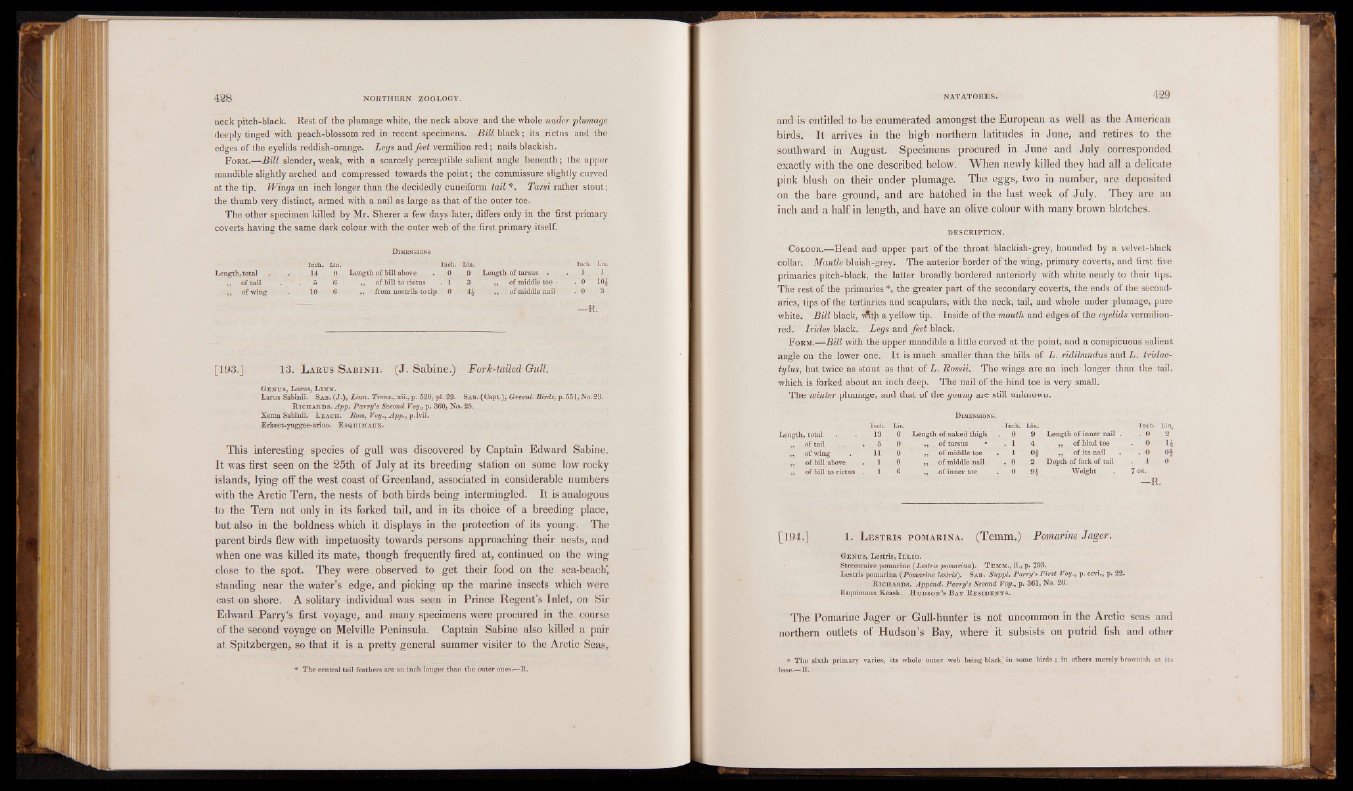
neck pitch-black. Rest of the plumage white, the neck above and the whole under •plumage
deeply tinged with peach-blossom red in recent specimens. Bill black; its rictus and the
edges of thfe eyelids reddish-orange. Legs and feet vermilion red; nails blackish.
Form.—Bill slender, weak, with a scarcely perceptible salient angle beneath; the upper
mandible slightly arched and compressed towards the point; the commissure slightly curved
at the tip. Wings an inch longer than the decidedly cuneiform tail#. Tarsi rather stout;
the thumb very distinct, armed with a nail as large as that of the outer toe.
The other specimen killed by Mr. Sherer a few days later, differs only in the first primary
coverts having the same dark colour with the outer web of the first primary itself.
Dimensions
Inch. T.ln, Inch. Lin. r‘ Inch. Lin.
Length, total 14 0 Length of bill above . 0 9 Length of tarsus . . 1 1
' of tail 5 6 ,, of bill to rictus . 1 3 ,, of middle toe • . 0 10}
. „ of wing 10 6 „ from nostrils to tip. 0 4* ,, . of middle nail . 0 3
' • — K.
[193.] 13. L a r u s S a b i n i i . (J. Sabine.) Fork-tailed Gull.
Genus, Larus, Lin n .
Larus Sabinii. Sab. (J.), Linn. Trans., xii., p. 520, pi. 29. Sab. (Capt.), Greenl. Birds, p. 551, No. 23. Richards. App. Parry's Second Voy., p. 360, No. 25.
Xema Sabinii. Leach. B oss, Voy., App., p.lvii.
Erkeet-yuggee-arioo. E squimaux.
This interesting species of gull was discovered by Captain Edward Sabine.
It was first seen on the 25th of July at its breeding station on some low rocky
islands, lying off the west coast of Greenland, associated in considerable numbers
with the Arctic Tern, the nests of both birds being intermingled. It is analogous
to the Tern not only in its forked tail, and in its choice of a breeding place,
but also in the boldness which it displays in the protection of its young. The
parent birds flew with impetuosity towards persons approaching their nests, and
when one was killed its mate, though frequently fired at, continued on the wing
close to the spot. They were observed to get their food on the sea-beach',
standing near the water’s edge, and picking up the marine insects which were
cast on shore. A solitary individual was seen in Prince Regent’s Inlet, on Sir
Edward Parry’s first voyage, and many specimens were procured in the course
of the second voyage on Melville Peninsula. Captain Sabine also killed a pair
at Spitzbergen, so that it is a pretty general summer visiter to the Arctic Seas,
The central tail feathers are an inch longer than the outer ones.—R.
and is entitled to be enumerated amongst the European as well as the American
birds. It arrives in the high northern latitudes in June, and retires to the
southward in August. Specimens procured in June and July corresponded
exactly with the one described below. When newly killed they had all a delicate
pink blush on their under plumage. The eggs, two in number, are deposited
on the bare ground, and are hatched in the last week of July. They are an
inch and a half in length, and have an olive colour with many brown blotches.
DESCRIPTION.
Colour.—Head and upper part of the throat blackish-grey, bounded by a velvet-black
collar. Mantle bluish-grey. The anterior border of the wing, primary coverts, and first five
primaries pitch-black, the latter broadly bordered anteriorly with white nearly to their tips.
The rest of the primaries *, the greater part of the secondary coverts, the ends of the secondaries,
tips of the tertiaries and scapulars, with the neck, tail, and whole under plumage, pure
white. Bill black, v^tji a yellow tip. Inside of the mouth and edges of the eyelids vermilion-
red.' Irides black. Legs and feet black.
Form.—Bill with the upper mandible a little curved at the point, and a conspicuous salient
angle on the lower one. It is much smaller than the bills of L. ridibundus and L. tridac-
tylus, but twice as stout as that of L. Rossii. The wings are an inch longer than the tail,
which is forked about an inch deep. The nail of the hind toe is very small.
The winter plumage, and that of the young are still unknown.
Dimensions.
Inch. Lin. Inch. Lin. Inch. Lin#
Length, total 13 6 Length of naked thigh . 0 9 Length of inner nail . . 0 2*
,, of tail . . . 5 0 „ of tarsus . 1 4 ,, of hind toe 0 1}
,, of wing 11 0 „ of middle toe . 1 0£ ,, of its nail . 0 0£
„ of bill above . 1 0 „ of middle nail . 0 2 Depth of fork of tail . 1 0
,, of bill to rictus 1 6 „ of inner toe . 0 9 i Weight 7 oz.
— R .
[194.] 1. L e s t r i s p o m a r i n a . (Temm.) Pomarine Jager.
Ge n u s , Lestris, I l l ig .
Stercoraire pomarine (Lestris pomarina'), T em m ., ii., p. 793.
Lestris pomarina ( Pomarine lestris). Sa b . Suppl. Parry’s First Voy., p. ccvi., p. 22.
R ic h a r d s . Append. Parry’s Second Voy., p. 361, No. 26.
Esquimaux Keask. H u d so n ’s B ay R e s id e n t s .
The Pomarine Jager or Gull-hunter is not uncommon in the Arctic seas and
northern outlets of Hudson’s Bay, where it subsists on putrid fish and other
* The sixth primary varies, its whole outer web being black] in some b ird s in others merely brownish at its
base.—R.